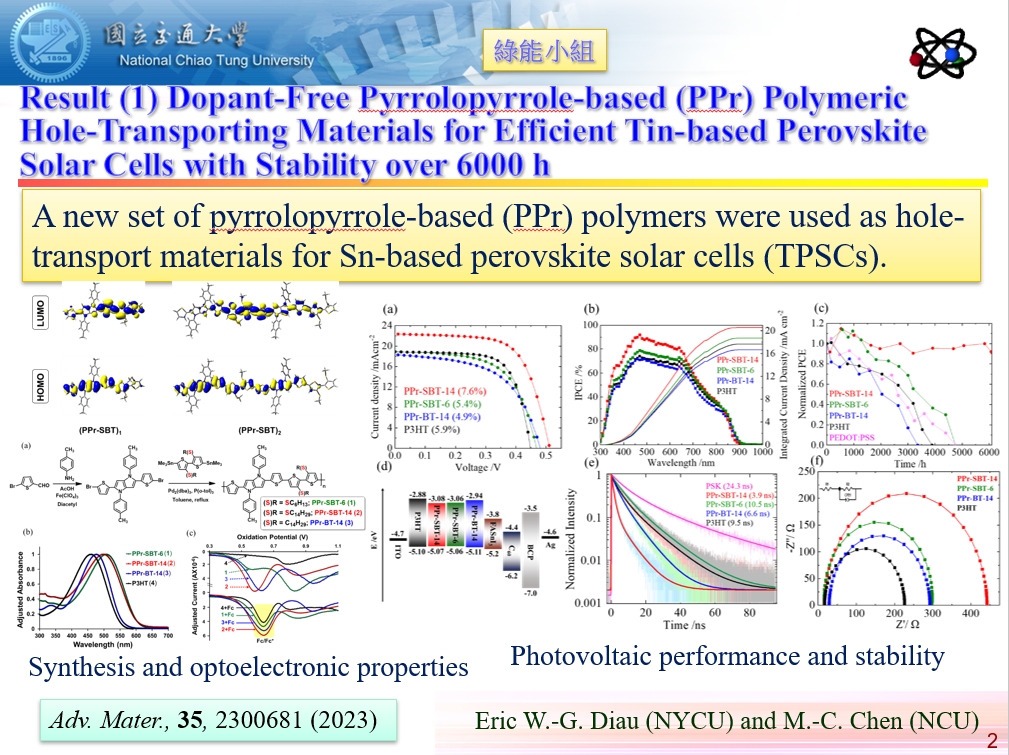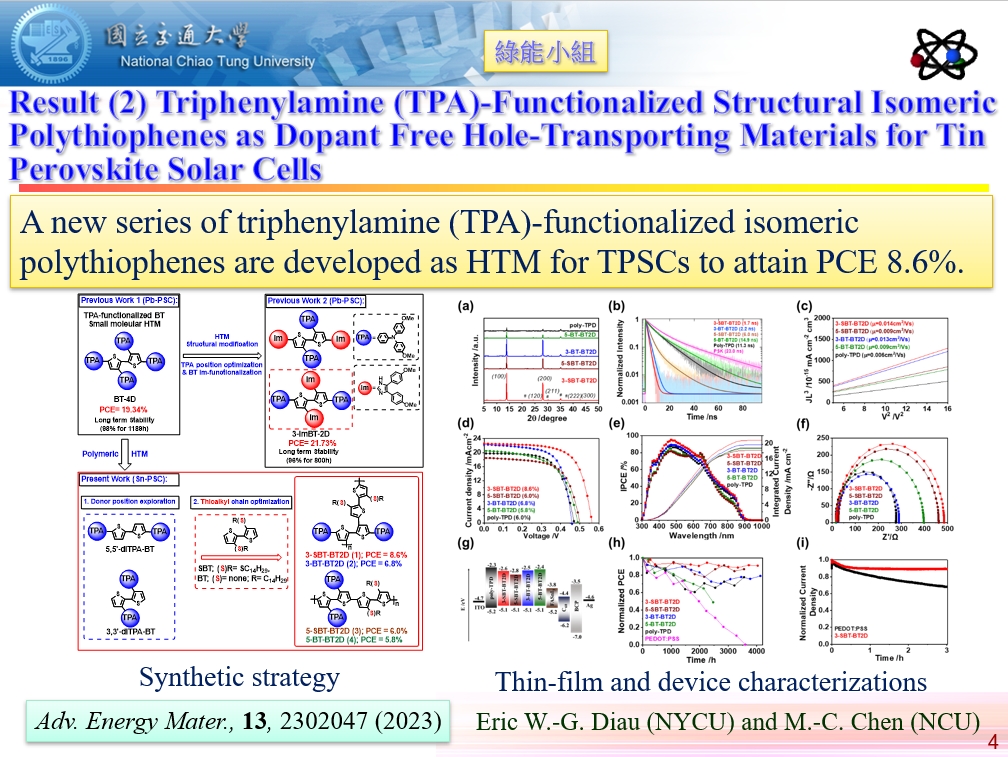

Dopant‐Free Pyrrolopyrrole‐based (PPr) Polymeric Hole‐Transporting Materials for Efficient Tin‐based Perovskite Solar Cells with Stability over 6000 h

A new set of pyrrolopyrrole-based (PPr) polymers incorporated with thioalkylated/alkylated bithiophene (SBT/BT) were synthesized and explored as hole-transporting materials (HTMs) for Sn-based perovskite solar cells (TPSCs). Three bithiophenyl spacers bearing the thioalkylated hexyl (SBT-6), thioalkylated tetradecyl (SBT-14), and tetradecyl (BT-14) chains were utilized to examine the effect of the alkyl chain lengths. Among them, the TPSCs were fabricated using PPr-SBT-14 as HTMs through a two-step approach by attaining a power conversion efficiency (PCE) of 7.6% with a remarkable long-term stability beyond 6000 hours, which has not been reported elsewhere for a non-PEDOT:PSS-based TPSC. The highly planar structure, strong intramolecular S(alkyl)···S(thiophene) interactions, and extended π-conjugation of SBT made the PPr-SBT-14 device outperform the standard P3HT and other devices. The longer thio-tetradecyl chain in SBT-14 restricts the molecular rotation and strongly affects the molecular conformation, solubility, and film wettability over other polymers. Thus, the present study makes a promising dopant-free polymeric HTM model for the future design of highly efficient and stable TPSCs.
Chun-Hsiao Kuan, Rajendiran Balasaravanan, Shih-Min Hsu, Jen-Shyang Ni, Yi-Tai Tsai, Zhong-Xiang Zhang, Ming-Chou Chen* and Eric Wei-Guang Diau,*,” Dopant-Free Pyrrolopyrrole-Based (PPr) Polymeric Hole-Transporting Materials for Efficient Tin-Based Perovskite Solar Cells with Stability Over 6000 h”, Adv. Mater., 35, 2300681 (2023).
Triphenylamine (TPA)-Functionalized Structural Isomeric Polythiophenes as Dopant Free Hole-Transporting Materials for Tin Perovskite Solar Cells

A new series of triphenylamine (TPA)-functionalized isomeric polythiophenes are developed as hole transporting materials (HTM) for inverted tin-based perovskite solar cells (TPSCs). Bithiophene (BT) was first functionalized with two TPA at 3 and 5 positions to give two structural isomeric compounds (3BT2D and 5BT2D). The functionalized BT2Ds were then coupled with SBT-14/BT-14 to produce structural isomeric polythiophenes. The TPA-functionalized polymers based TPSCs exhibit enhance operational stability and efficiency. The long thiotetradecyl chain in SBT-14 with intramolecular S(alkyl)∙∙∙S(thio) interactions restricts the molecular rotation and has a strong impact on the molecular solubility and wettability of the film during device fabrication. Among all the polymers studied, TPSCs fabricated with 3-SBT-BT2D polymer exhibit the highest hole mobility as well as the slowest charge recombination and achieve the highest power conversion efficiency (PCE) of 8.6%, with a great long-term stability for the performance retaining ~90% of its initial values for shelf storage over 4000 h, which is the best efficiency for non-PEDOT:PSS-based TPSCs ever reported.
Rajendiran Balasaravanan, Chun-Hsiao Kuan, Shih-Min Hsu, En-Chi Chang, Yu-Cheng Chen, Yi-Tai Tsai, Meng-Li Jhou, Shueh-Lin Yau, Cheng-Liang Liu, Ming-Chou Chen* and Eric Wei-Guang Diau*, “Triphenylamine (TPA)-Functionalized Structural Isomeric Polythiophenes as Dopant Free Hole-Transporting Materials for Tin Perovskite Solar Cells”, Adv. Energy Mater., 13, 2302047 (2023).